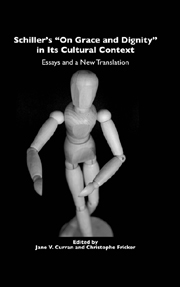Introduction
Published online by Cambridge University Press: 05 February 2013
Summary
Pygmalion creates statues marked by a certain majesty but lacking grace. Only when the goddess of beauty appears to the artist in a dream is he capable of making statues so perfect that he wishes them to come alive. This eventually happens, and the figure moves gracefully. This version of the myth of Pygmalion with its notable opposition of two characteristics comes from the French Enlightenment author André-François Boureau-Deslandes. It speaks to us even today: we still talk about dignity of bearing and about grace if we are attracted to a person because of a special air about him or her. At first glance, the concepts seem to be complementary.
For millennia, philosophers and poets have tried to define grace. The discussion usually starts by referring to grace as a gift granted by a divine being for a limited time. This gift becomes visible in the posture and movements of a person. It has thus to be interpreted primarily from an aesthetic viewpoint. The connection with a transcendental sphere changes its meaning in the eighteenth century; it loses its religious dimension but remains important as a reference point. The transcendental becomes the vanishing point for concepts unable to come to terms with undeniable and attractive appearances. This inadequacy of definitions, this je ne sais quoi, is ever present. Grace, in an Enlightenment context, becomes a “kulturphilosophische Heilskategorie” (a cultural and philosophical road to salvation). It thus fulfills the function of an educational standard in a time when bourgeois society is trying to define itself.
- Type
- Chapter
- Information
- Schiller's 'On Grace and Dignity' in its Cultural ContextEssays and a New Translation, pp. 1 - 18Publisher: Boydell & BrewerPrint publication year: 2005

